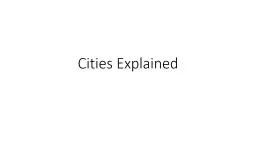

1st In order for a piece of land to be classified as a city it needs three major components The first aspect of a city is people In order to be seen as a city it needs 100000 people The second part of a city is resources In order to flourish and grow cities need access to food ID: 645373
Download Presentation The PPT/PDF document "Cities Explained What is a city" is the property of its rightful owner. Permission is granted to download and print the materials on this web site for personal, non-commercial use only, and to display it on your personal computer provided you do not modify the materials and that you retain all copyright notices contained in the materials. By downloading content from our website, you accept the terms of this agreement.
Slide1
Cities ExplainedSlide2
What is a city? – 1st
In order for a piece of land to be classified as a city, it needs three major components. The first aspect of a city is people. In order to be seen as a city, it needs 100,000 people. The second part of a city is resources. In order to flourish and grow, cities need access to food, water, and housing. The final component is government and jobs. Effective leadership is important and having jobs helps people spend money to boost the economy. When all of these things are present, a city can function.Slide3
What is a city? – 5th
In order for a piece of land to be classified as a city, it needs three major components. The first aspect of a city is people; in order to be recognized as a city, it needs at least 100,000 people. The second part of a city is access to resources. The major resources people need are food, water, and housing. The final component is government and jobs. In order to run successfully, people need leadership and, to help the economy, they need jobs. When all of these things are present, a city can function.Slide4
What makes a great city? – 1st
Despite the fact that all cities have the same basics, there are some differences that make some cities better than others. I will explain three of these here.
The first aspect of a great city is a good, diverse community. Having different kinds of people brings unique perspectives that allows all people to be served properly.
The second benefit of a good city is the ability to attract visitors. Some of the best cities have preserved history, fancy parks, or one-of-a-kind exhibits.
The final thing great cities have is safe streets. Having citizens that respect their city as well as police and fire departments that work hard to maintain the city are paramount to a great city.
These are just some of the aspects of a great city.Slide5
What makes a great city? – 5th
Despite the fact that all cities have the same basics, there are some differences that make some cities better than others. I will explain three of these here
.
The first aspect of a great city
is a strong community. This means people work together to keep the city safe and achieve common goals.
The second benefit of a great city is transportation and places for people to go and visit. This includes stadiums, malls, and parks. There also should be a transportation system like buses or trains to avoid massive traffic.
The final things great cities have is a safe environment. These include police, fire, hospitals, and a military base.
These are just some aspects of a great city.Slide6
Problems – 1st
Despite the best efforts of city planners, mayors, city councils, and the like, there are still problems in cities. I will explain some of the major problems I see in cities.
First, there is crime. Safety in a city is usually the most important selling point to attract future citizens as well as keeping current citizens.
Secondly, there is a lack of funding for public services. This includes education, parks, police, fire, and libraries.
The final major problem that cities face is overcrowding and lack of appropriate housing. The need for new residential communities is becoming a necessity.
These are just a small sampling of current city problems. Unfortunately, there are many more. Slide7
Problems – 5th
Despite the best efforts of city planners, mayors, city councils, and the like, there are still problems in cities. I will explain some of the major problems I see in cities.
The first issue in cities is crime. City leaders are always looking for ways to make the city safer for their citizens.
The second problem in cities is underfunding for education and healthcare. Citizens need a good education and proper access to good healthcare in order to function properly.
The final problem to address is overcrowding and overpopulation. These problems create a need for more roads and better quality and availability of housing.
This is just a small sampling of the many
problems cities face today.